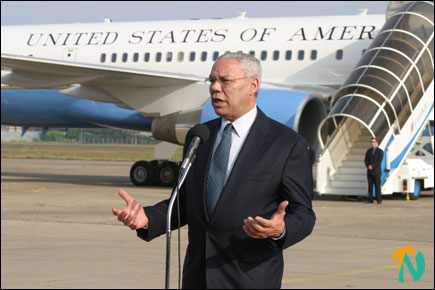
Powell in Colombo, 2005.
This week, former US Secretary of State Colin Powell passed away from COVID-19 related complications, aged 84 years old.
Powell will be remembered as being the first African-American US Secretary of State and also for his role in garnering international support for the US invasion of Iraq.
We look back on his interactions and remarks on Sri Lanka, the faltering peace process between the Sri Lankan government and Liberation Tigers of Tamil Eelam (LTTE) and Washington’s support for Colombo that empowered the Rajapaksa regime and its military offensive.
The first visit
Sri Lanka was not new to Powell. Indeed, his first visit to the island came in 1983 as senior military assistant to Secretary of Defense Caspar Weinberger. The trip came just months after state-backed Sinhala mobs killed thousands of Tamils in the Black July pogrom, and amidst growing clashes between the military and Tamil militants.
“On a stop for fuel in Sri Lanka, [Weinberger] took a helicopter to have tea with President J. R. Jayewardene,” wrote the New York Times.
Powell would go on to grow in prominence, becoming Ronald Reagan's National Security Advisor and Chairman of the Joint Chiefs of Staff - the highest military position in the US Department of Defense.
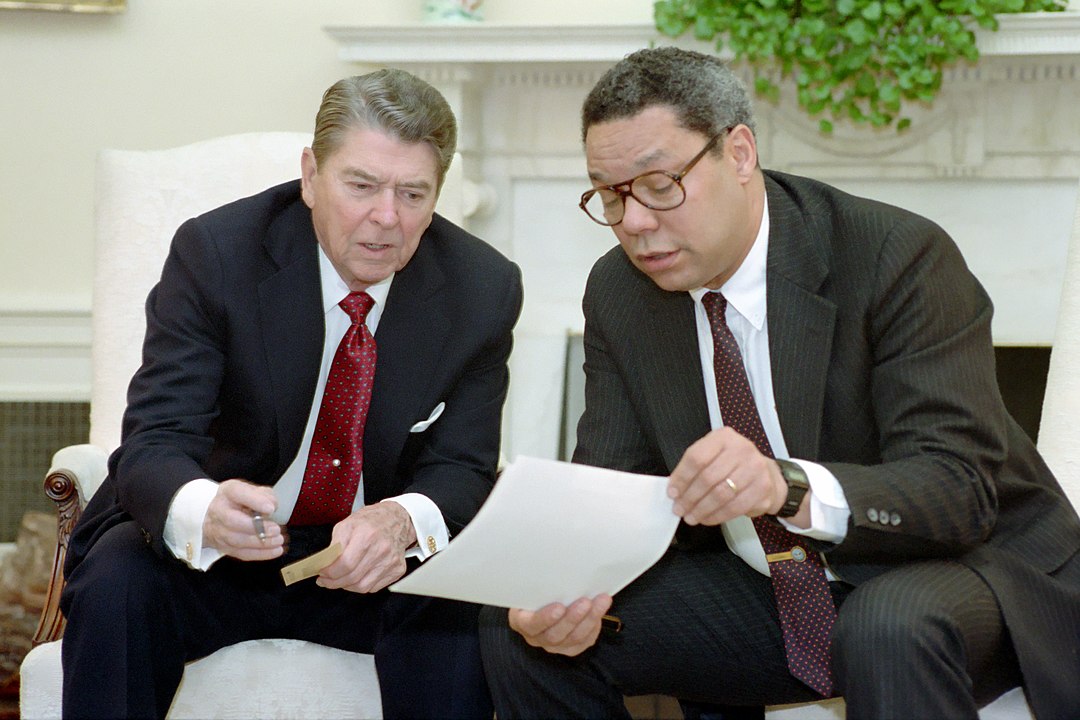
Powell with Reagan, 1988.
Secretary of State
On January 20, 2001, Powell took up office as the 65th United States Secretary of State under then US president George W Bush.
On the island, Eelam War II had raged with the LTTE gaining ground and the Sri Lankan army on the receiving end of a series of humiliating setbacks. Elephant Pass, a garrison described as "impregnable" by a US army officer who visited months before, had been captured by the LTTE in April 2000, before a unilateral ceasefire was declared on December 24, 2000. Despite then-Sri Lankan president Chandrika Kumaratunga’s rejection of the ceasefire, it was extended unilaterally for four more months, until 24 April 2001, just weeks after Powell had taken office.
As fighting resumed, in the early hours of 24 July 2001, a team of 14 LTTE commandos infiltrated and attacked the Sri Lankan Air Force Base in Katunayake, destroying several aircraft and causing over US$500 million worth of damage without a single civilian fatality. On February 22, 2002, the leader of the LTTE Velupillai Prabhakaran signed a ceasefire agreement, followed by Sri Lankan prime minister Ranil Wickremesinghe.
The period that followed saw the US enhance its engagement in Sri Lanka according to former US Ambassador to Sri Lanka Jeffrey Lunstead, who cited the Bush administration’s global war on terror, the pro-West and pro-free market policies of the newly elected Wickremesinghe government and the personal interest of then-Deputy Secretary of State Richard Armitage as the rationale for the growing ties between Colombo and Washington.
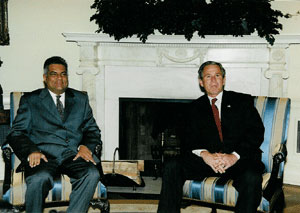
Wickremesinghe with Bush, 2002.
In July 2002, Wickremesinghe flew to Washington, where he met with President Bush and Secretary of State Powell. According to the Sri Lankan embassy in the US, Powell “the Secretary of State indicated that the United States would consider all possible assistance once the assessment teams visited Sri Lanka and reported back to the Administration.”
Accompanied by Milinda Moragoda, Wickremesinghe also held several other meetings, including with National Security Advisor Condoleezza Rice, Senators John McCain and Hilary Clinton and the World Bank.
As talks between the LTTE and Sri Lankan government continued, the US position of support for Colombo was becoming increasingly clear. Even after two rounds of talks between the warring parties, Deputy Secretary of State Armitage said in his address to an international donor conference in Oslo that the LTTE must “go one step further and add to this commitment a public renunciation of terrorism and violence to make it clear to the people of Sri Lanka and indeed the international community that the LTTE has abandoned its armed struggle for a separate state”. The comments were slammed as “unwarranted” and “provocative” by Anton Balasingham, the then chief negotiator for the LTTE.
With Washington’s ties with Colombo growing closer, Powell met with Sri Lanka’s ambassador to the US in January 2003, where he reportedly said, “the United States Government was closely following developments in Sri Lanka and was committed to support Sri Lanka not only by word but also in terms of substance”.
Talks between the LTTE and Sri Lankan government were producing few tangible outcomes, yet the US administration went on to take the extraordinary step of excluding the LTTE from an international donor meeting to be held in Washington on 14 and 15 April 2003 – a move that “dismayed and disappointed” the LTTE and further clarified the US position on the island.
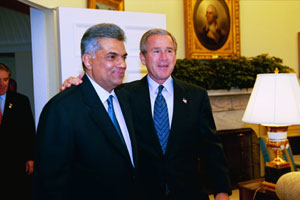
Wickremesinghe with Bush again in 2003.
In the south meanwhile, tensions between president Kumaratunga and prime minister Wickremesinghe were reaching a fever pitch. In November, whilst Wickremesinghe was on yet another visit to the White House, Kumaratunga prorogued Parliament and took over Defence, Interior and Media ministries.
As the southern infighting continued, Powell would write directly to both Kumaratunga and Wickremesinghe in early 2004, urging them to resolve the political crisis and for the early resumption of the peace talks with the LTTE.
His call was in vain, as Kumaratunga went on to form a hard-line alliance with the JVP and called fresh elections with Mahinda Rajapaksa subsequently appointed as Prime Minister.
Meeting with Kadirgamar
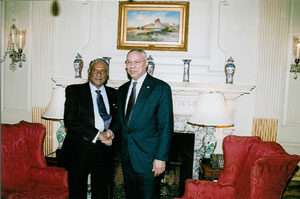
Powell would next directly interact with Sri Lankan officials when Lakshman Kadirgamar, Rajapaksa’s newly appointed foreign minister, travelled to Washington to meet with him.
"Minister Kadirgamar, during his meeting with the Secretary of State, apprised Secretary Powell of the policies of the new Government and reiterated its desire to achieve a secure, just and lasting peace for the benefit of all communities of Sri Lanka," said a Sri Lankan government press release. "The Minister thanked the United States for the principled stand it had taken over the years in support of Sri Lanka’s territorial integrity and sovereignty and for playing a positive role with regard to the Sri Lanka peace process."
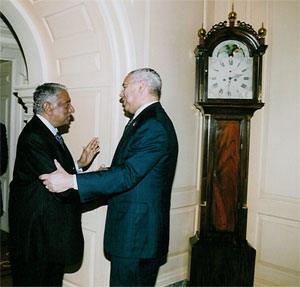
Just weeks later, Kadirgamar would write a gushing letter to Powell, urging him to visit Sri Lanka and to make time “to see at least some of the sites, both scenic and historical, for which Sri Lanka is famous.”
Powell’s visit to the island would come soon, but in a manner that none had predicted.
Boxing Day Tsunami
On December 26, 2004, over 35,000 people perished during the catastrophic tsunami that hit the coasts of the North-East and South of the island of Sri Lanka. The United Nations High Commission for Refugees (UNHCR) said five days after the disaster that almost two-thirds of those killed across the island were in the Tamil homeland of the North-East.
In the immediate aftermath of the disaster, the Bush administration announced it would send 1500 US Marine troops to the island with at least five hovercrafts and 20 helicopters. The arrival of the US Marines was to coincide with an official visit by the outgoing Secretary of State, Colin Powell.
Powell only toured the south of the island, with the Sri Lankan state openly blocking officials such as then UN Secretary-General Kofi Annan from visiting the North-East.
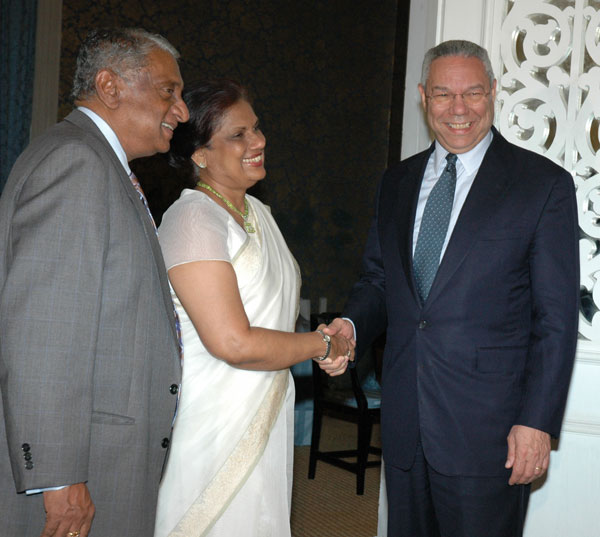
Powell with Kumaratunga and Kadirgamar.
Speaking at a press briefing held at the runway at the Katunayake Air Force Base in Colombo, Powell said he had completed “a series of meetings with the President of Sri Lanka, the opposition leader, and members of the President’s cabinet, as well as a helicopter and on-the-ground tour down in Galle.”
See extracts from his remarks to reporters below.
QUESTION: Have you received any guarantees from the Tamil Tigers or had any contact with them regarding aid that might be going their way?
SECRETARY POWELL: I haven’t had any contact with them. The reports I received from the government suggest that aid is going into the northern part of the country, those parts of the country that are under their control. The government believes that the Tamil regions are getting as much or more as their proportion. We’ll have to wait and measure that over time. But, I know that aid is going up there, but I have had no conversation with any of the members of the LTTE.
QUESTION: Are you satisfied with the Sri Lankan government’s relief effort?
SECRETARY POWELL: Yes, I was very impressed at how quickly they have completed their assessment of losses, of where the priorities need to be and of what they need to do. I think it’s an impressive piece of work and it certainly gives me confidence that they know how to spend the relief money and know how to distribute the supplies and equipment that will be coming into the country.
QUESTION: Considering the significant U.S. presence in Sri Lanka at present, what is the role of the U.S. going to be in the future of Sri Lanka’s peace process?
SECRETARY POWELL: As you know, we have always tried to play a helpful role working with our Norwegian colleagues. I have followed the situation very, very closely. My Deputy Secretary, Mr. Armitage, has been deeply involved in the process. I don’t think our military presence in any way shapes or affects the political situation. Ultimately, the problem has to be solved between the parties concerned. The United States military presence is strictly for humanitarian purposes and not in any way to influence the political outcome one way or the other.
We are hopeful, however, that if all Sri Lankans come together to deal with this common catastrophe, this common crisis, and work with each other and cooperate with each other, then perhaps that spirit of cooperation can be elevated and extended into the political dialogue and find a way forward to a political solution to this long-standing crisis between the government and LTTE.
The aftermath
Roughly a month after the tsunami, on Jan 28, complaints of the failure of the Sri Lankan government to provide aid relief to the North-East continued. The Tamil people and the LTTE, from the onset, had low expectations of seeing international aid that was given to the Sri Lankan government ever reaching the worst affected Tamil regions of the island. Whilst billions of dollars of official foreign aid was pledged for Sri Lanka, very little trickled through to the North-East. International aid was blocked and diverted to the south. Aid from the Tamil Diaspora was also blocked and sometimes appropriated. An agreement to jointly distribute $3 billion of aid, the P-TOMS, was scrapped just months after the disaster, when Sri Lanka’s new president Mahinda Rajapaksa took charge.
Five years after the disaster, in December 2009, Transparency International, said that nearly half a billion dollars given to Sri Lanka in tsunami aid was unaccounted for, whilst a further $600 million had been spent on projects unrelated to the disaster.
Read more in our feature: Remembering the waves - 12 years on from the tsunami
The years after the tsunami are however better remembered for Sri Lanka’s return to conflict. A heavily expanded Sri Lankan military abrogated the cease fire agreement and launched a massive military offensive, with substantial US support.
“All in all I would say that the war could not have been won without US help, their strategic inputs,” said Devinda Subasinghe, former Sri Lankan ambassador to the United States.
“The arming was done by the Chinese, Pakistan and the Israelis to some extent: but the strategic inputs came from [the] US. From the Israelis we got cannons, radars, UAVs. All of that was in the space that the CFA provided, and because of the forward-leaning leadership that the US took, thanks to [Richard] Armitage. By 2009 we had benefitted from everything that Washington was doing. I think those were critical interventions, without which we would not have got to where we ended up.”
Tens of thousands of Tamil civilians were to be massacred in the years that followed, with hospitals repeatedly bombed, embargoes of food and medicine and widespread sexual violence. Almost all of the military and political leadership of the LTTE were killed and the Sri Lankan military continues to occupy the Tamil North-East, maintaining a massive defence budget and overwhelming deployment more than 12 years since the end of the armed conflict.
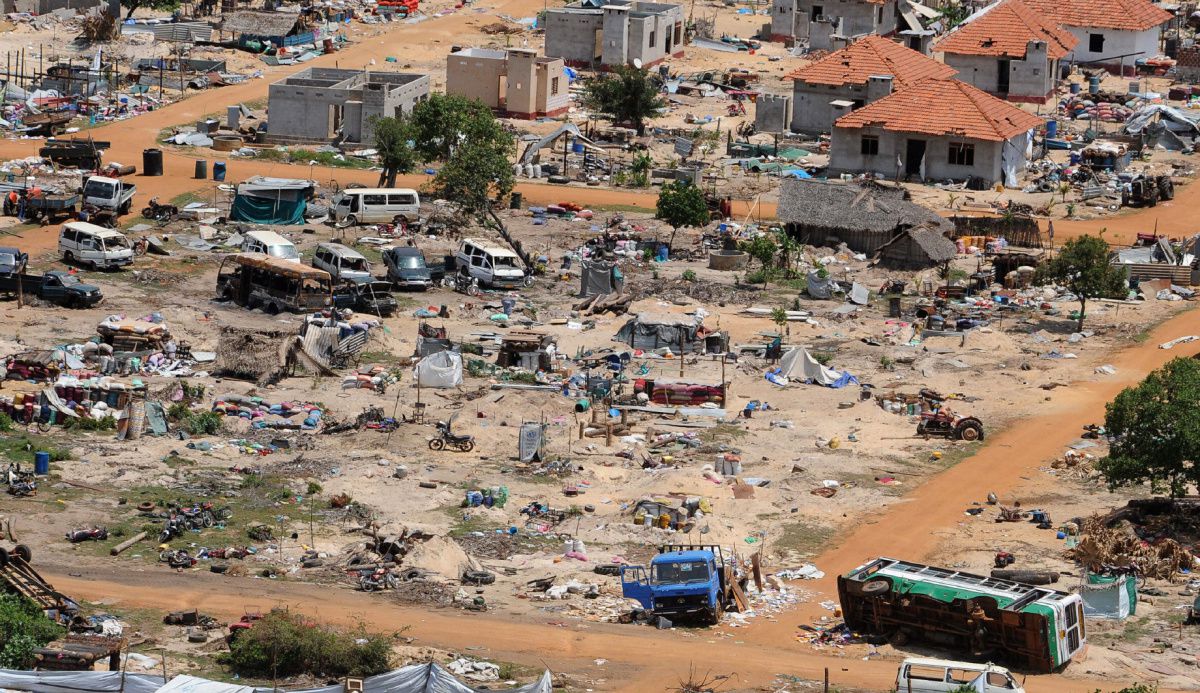
The aftermath of the massacre at Mullivaikkal.
The Bush administration’s position on Sri Lanka was perhaps best described by US Under Secretary for Political Affairs R. Nicholas Burns after a Co-Chairs meeting in Washington in 2006:
“I'd just say on behalf of the United States that we have faith in the government and faith in the president of Sri Lanka. They do want to make peace. We also believe that the Tamil Tigers, the LTTE, is a terrorist group responsible for massive bloodshed in the country and we hold the Tamil Tigers responsible for much of what has gone wrong in the country. We are not neutral in this respect. We support the government. We have a good relationship with the government. We believe the government has a right to try to protect the territorial integrity and sovereignty of the country. The government has a right to protect the stability and security in the country.
We meet often with the government at the highest levels and consider the government to be a friend to our country.”
